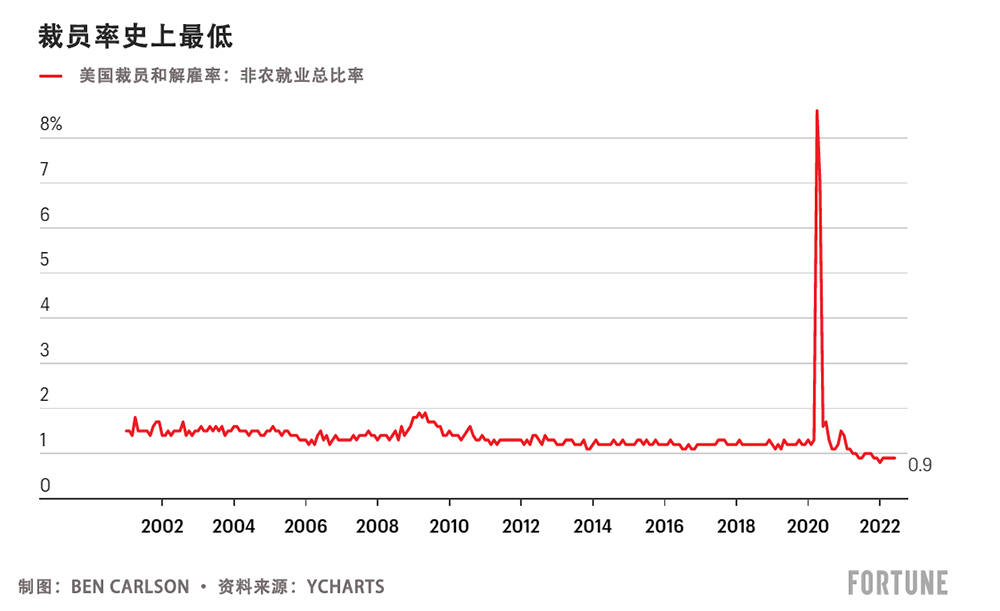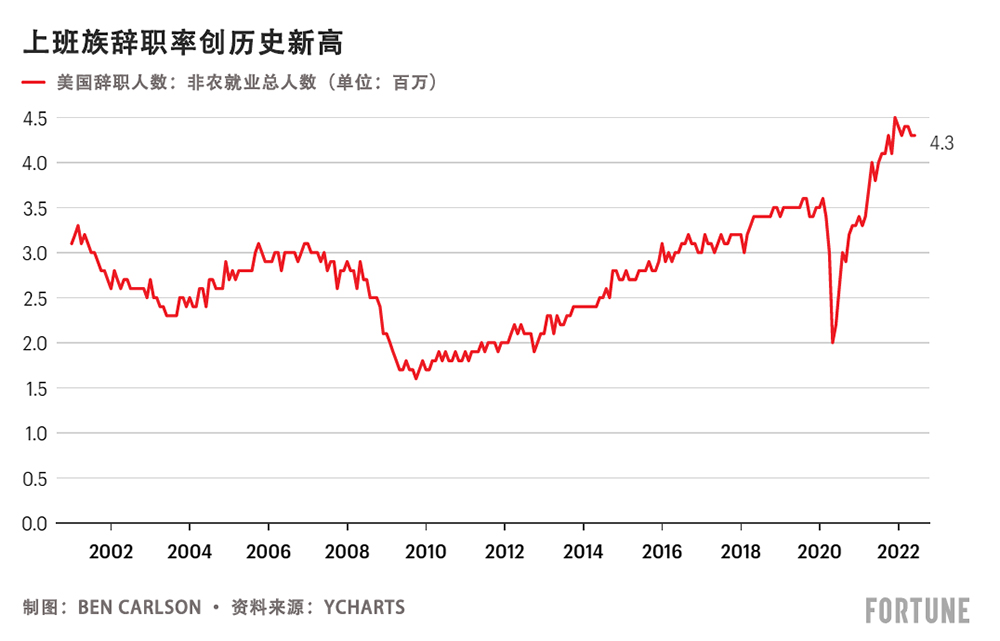
今年7月中旬,,美國的通脹率同比上漲9.1%,再次刷新40年最高水平,。
美聯(lián)儲(Federal Reserve)的態(tài)度已經(jīng)非常明確,,他們將繼續(xù)加息,直到通脹水平下降為止,。
美聯(lián)儲通過收緊貨幣政策減低通脹,,通常都會導致經(jīng)濟衰退。因此,,過去幾個月有關(guān)經(jīng)濟衰退的話題愈演愈烈,,出現(xiàn)這種情況不足為奇,。似乎所有人都在密切關(guān)注經(jīng)濟衰退問題,就連我的妻子也不例外,。
她最近問我:“你如何定義什么才是經(jīng)濟衰退,?”
要給她一個好的定義,并不像看起來那么容易,。金融界的大多數(shù)人認為經(jīng)濟衰退是指實際GDP連續(xù)兩個季度萎縮,。這個簡單的定義當然有道理,即便不是經(jīng)濟學家也能夠理解,。
問題是,,在前三次經(jīng)濟衰退中,有兩次并不符合這個定義,。2020年的經(jīng)濟衰退是史上持續(xù)時間最短的一次,,僅持續(xù)了兩個月,而不是兩個季度,。在2001年短暫的經(jīng)濟衰退期間,,實際GDP也沒有連續(xù)兩個季度萎縮。
這是因為對經(jīng)濟衰退的官方認定是來自美國國家經(jīng)濟研究局(National Bureau of Economic Research)的一批經(jīng)濟學家,,他們在認定過程中除了實際GDP以外,,還會使用多個指標。
美國國家經(jīng)濟研究局這樣描述他們的商業(yè)周期監(jiān)測(Business Cycle Dating)指標:
美國國家經(jīng)濟研究局的定義強調(diào),,經(jīng)濟衰退是指總體經(jīng)濟活動大幅減少,,并且持續(xù)數(shù)月。在我們對這個定義的解讀中,,我們確定了三個可以相互替換的指標:深度,、擴散性和持續(xù)時間。
確定經(jīng)濟峰谷的基礎是聯(lián)邦統(tǒng)計部門發(fā)布的一系列月度整體實際經(jīng)濟活動指標,。其中包括扣除轉(zhuǎn)移收入的個人實際收入,、非農(nóng)就業(yè)人數(shù)、通過家庭普查統(tǒng)計的就業(yè)數(shù)據(jù),、個人實際消費支出,、物價變動調(diào)整后批發(fā)零售銷售額和工業(yè)產(chǎn)值等。在這個過程中,,關(guān)于哪些指標會提供信息或者這些指標在我們決策中的比重,,并沒有固定的規(guī)則。最近幾十年,,我們最重視的兩個指標是扣除轉(zhuǎn)移收入的個人實際收入和非農(nóng)就業(yè)人數(shù),。
雖然這兩個指標讀起來很長,但我們將其總結(jié)為收入與就業(yè),。如果收入和就業(yè)下滑,,經(jīng)濟產(chǎn)出就很有可能減少,。
當前經(jīng)濟局勢的奇怪之處在于,經(jīng)濟產(chǎn)出增長放緩,,但收入和勞動力市場依舊穩(wěn)健,。今年第一季度的實際GDP增速下滑。第二季度很有可能會持續(xù)下滑,。
盡管如此,,勞動力市場卻依舊堅挺。到5月底,,即使將通脹考慮在內(nèi),,美國家庭收入依舊創(chuàng)歷史新高。
在新冠疫情之前,,最低裁員率為1.1%,。過去一年多,裁員率一直低于這個水平:

而出現(xiàn)這種情況的同時,,辭職率卻遠高于新冠疫情之前的水平:

有數(shù)百萬人對自己的財務狀況或找到新工作的能力足夠自信,,愿意辭掉當前的工作。而員工被裁員的比率卻是歷史最低水平,。這些都是勞動力市場健康的標志,。
失業(yè)率依舊只有3.6%,。美國經(jīng)濟在今年第一季度新增160萬個就業(yè)崗位,。第二季度增加了110萬個就業(yè)崗位。
我從這些數(shù)據(jù)中看不出經(jīng)濟衰退的跡象,。
現(xiàn)在,,隨著美聯(lián)儲加息和通脹居高不下,未來幾個月,,個人收入可能減少,,失業(yè)率可能上升。
但我們也越來越有可能看到在這些指標依舊堅挺的時候,,實際GDP萎縮,。如果出現(xiàn)這種情況,有些人可能就會陷入恐慌,。有人希望對經(jīng)濟衰退的預測是正確的,。金融行業(yè)的從業(yè)者自然感到悲觀。有人認為經(jīng)濟系統(tǒng)被非法操縱,。有人只是希望世界毀滅,。
事實上,如果實際GDP連續(xù)兩個季度下降,,但美國國家經(jīng)濟研究局并未官方認定經(jīng)濟衰退,,這對大多數(shù)的普通人來說并不重要,。政策分析者、宏觀經(jīng)濟分析師和像我這樣的市場分析師認為這種情況很有趣,,所以會有所關(guān)注,,但對普通人來說,真正重要的是個人的經(jīng)濟狀況,。
俗話說得好,,當你的鄰居失業(yè)時就是經(jīng)濟衰退,當你自己失業(yè)時就是經(jīng)濟蕭條,。
如果你在未來幾個月被解雇,,一些經(jīng)濟學家們?nèi)绾卧u價經(jīng)濟狀況就都將變得無所謂。你會從情感和財務上有切身感受,。失業(yè)無論發(fā)生在經(jīng)濟周期的哪個時期,,都是個人的經(jīng)濟衰退。
即使我們按照經(jīng)濟衰退的官方定義來理解,,如果你可以保住工作,,能夠繼續(xù)儲蓄,并且避免在受沖擊的經(jīng)濟領(lǐng)域內(nèi)就業(yè),,這樣你個人就不會感覺到經(jīng)濟衰退,。
失業(yè)率、通脹率,、個人平均收入,、儲蓄率和其他經(jīng)濟數(shù)據(jù),確實可以幫助理解總體經(jīng)濟趨勢,。
但沒有任何個人或家庭能夠代表這些平均數(shù)據(jù),。我們每個人都有自己獨特的偏好、消費習慣,、財務狀況和生活環(huán)境,。
爭論經(jīng)濟衰退的定義可能有些吹毛求疵,但我只是希望大家為未來幾個月可能出現(xiàn)的一種奇怪的經(jīng)濟狀況做好準備:有人認為我們陷入了經(jīng)濟衰退,,但有人卻極力反駁這種觀點,。
讓自己為可能更加離奇的經(jīng)濟狀況做好準備。(財富中文網(wǎng))
本文作者的個人投資組合或里薩茲財富管理公司(Ritholtz Wealth Management)管理的投資組合中可能目前持有,、一直持有或未來可能持有本文提及的個別證券,。
譯者:劉進龍
審校:汪皓
今年7月中旬,美國的通脹率同比上漲9.1%,,再次刷新40年最高水平,。
美聯(lián)儲(Federal Reserve)的態(tài)度已經(jīng)非常明確,他們將繼續(xù)加息,直到通脹水平下降為止,。
美聯(lián)儲通過收緊貨幣政策減低通脹,,通常都會導致經(jīng)濟衰退。因此,,過去幾個月有關(guān)經(jīng)濟衰退的話題愈演愈烈,,出現(xiàn)這種情況不足為奇。似乎所有人都在密切關(guān)注經(jīng)濟衰退問題,,就連我的妻子也不例外,。
她最近問我:“你如何定義什么才是經(jīng)濟衰退?”
要給她一個好的定義,,并不像看起來那么容易,。金融界的大多數(shù)人認為經(jīng)濟衰退是指實際GDP連續(xù)兩個季度萎縮。這個簡單的定義當然有道理,,即便不是經(jīng)濟學家也能夠理解,。
問題是,在前三次經(jīng)濟衰退中,,有兩次并不符合這個定義,。2020年的經(jīng)濟衰退是史上持續(xù)時間最短的一次,僅持續(xù)了兩個月,,而不是兩個季度,。在2001年短暫的經(jīng)濟衰退期間,實際GDP也沒有連續(xù)兩個季度萎縮,。
這是因為對經(jīng)濟衰退的官方認定是來自美國國家經(jīng)濟研究局(National Bureau of Economic Research)的一批經(jīng)濟學家,,他們在認定過程中除了實際GDP以外,還會使用多個指標,。
美國國家經(jīng)濟研究局這樣描述他們的商業(yè)周期監(jiān)測(Business Cycle Dating)指標:
美國國家經(jīng)濟研究局的定義強調(diào),,經(jīng)濟衰退是指總體經(jīng)濟活動大幅減少,,并且持續(xù)數(shù)月,。在我們對這個定義的解讀中,我們確定了三個可以相互替換的指標:深度,、擴散性和持續(xù)時間,。
確定經(jīng)濟峰谷的基礎是聯(lián)邦統(tǒng)計部門發(fā)布的一系列月度整體實際經(jīng)濟活動指標。其中包括扣除轉(zhuǎn)移收入的個人實際收入,、非農(nóng)就業(yè)人數(shù),、通過家庭普查統(tǒng)計的就業(yè)數(shù)據(jù)、個人實際消費支出,、物價變動調(diào)整后批發(fā)零售銷售額和工業(yè)產(chǎn)值等,。在這個過程中,關(guān)于哪些指標會提供信息或者這些指標在我們決策中的比重,并沒有固定的規(guī)則,。最近幾十年,,我們最重視的兩個指標是扣除轉(zhuǎn)移收入的個人實際收入和非農(nóng)就業(yè)人數(shù)。
雖然這兩個指標讀起來很長,,但我們將其總結(jié)為收入與就業(yè),。如果收入和就業(yè)下滑,經(jīng)濟產(chǎn)出就很有可能減少,。
當前經(jīng)濟局勢的奇怪之處在于,,經(jīng)濟產(chǎn)出增長放緩,但收入和勞動力市場依舊穩(wěn)健,。今年第一季度的實際GDP增速下滑,。第二季度很有可能會持續(xù)下滑。
盡管如此,,勞動力市場卻依舊堅挺,。到5月底,即使將通脹考慮在內(nèi),,美國家庭收入依舊創(chuàng)歷史新高,。
在新冠疫情之前,最低裁員率為1.1%,。過去一年多,,裁員率一直低于這個水平:
而出現(xiàn)這種情況的同時,辭職率卻遠高于新冠疫情之前的水平:
有數(shù)百萬人對自己的財務狀況或找到新工作的能力足夠自信,,愿意辭掉當前的工作,。而員工被裁員的比率卻是歷史最低水平。這些都是勞動力市場健康的標志,。
失業(yè)率依舊只有3.6%,。美國經(jīng)濟在今年第一季度新增160萬個就業(yè)崗位。第二季度增加了110萬個就業(yè)崗位,。
我從這些數(shù)據(jù)中看不出經(jīng)濟衰退的跡象,。
現(xiàn)在,隨著美聯(lián)儲加息和通脹居高不下,,未來幾個月,,個人收入可能減少,失業(yè)率可能上升,。
但我們也越來越有可能看到在這些指標依舊堅挺的時候,,實際GDP萎縮。如果出現(xiàn)這種情況,,有些人可能就會陷入恐慌,。有人希望對經(jīng)濟衰退的預測是正確的,。金融行業(yè)的從業(yè)者自然感到悲觀。有人認為經(jīng)濟系統(tǒng)被非法操縱,。有人只是希望世界毀滅,。
事實上,如果實際GDP連續(xù)兩個季度下降,,但美國國家經(jīng)濟研究局并未官方認定經(jīng)濟衰退,,這對大多數(shù)的普通人來說并不重要。政策分析者,、宏觀經(jīng)濟分析師和像我這樣的市場分析師認為這種情況很有趣,,所以會有所關(guān)注,但對普通人來說,,真正重要的是個人的經(jīng)濟狀況,。
俗話說得好,當你的鄰居失業(yè)時就是經(jīng)濟衰退,,當你自己失業(yè)時就是經(jīng)濟蕭條,。
如果你在未來幾個月被解雇,一些經(jīng)濟學家們?nèi)绾卧u價經(jīng)濟狀況就都將變得無所謂,。你會從情感和財務上有切身感受,。失業(yè)無論發(fā)生在經(jīng)濟周期的哪個時期,都是個人的經(jīng)濟衰退,。
即使我們按照經(jīng)濟衰退的官方定義來理解,,如果你可以保住工作,能夠繼續(xù)儲蓄,,并且避免在受沖擊的經(jīng)濟領(lǐng)域內(nèi)就業(yè),,這樣你個人就不會感覺到經(jīng)濟衰退。
失業(yè)率,、通脹率,、個人平均收入、儲蓄率和其他經(jīng)濟數(shù)據(jù),,確實可以幫助理解總體經(jīng)濟趨勢,。
但沒有任何個人或家庭能夠代表這些平均數(shù)據(jù)。我們每個人都有自己獨特的偏好,、消費習慣,、財務狀況和生活環(huán)境,。
爭論經(jīng)濟衰退的定義可能有些吹毛求疵,,但我只是希望大家為未來幾個月可能出現(xiàn)的一種奇怪的經(jīng)濟狀況做好準備:有人認為我們陷入了經(jīng)濟衰退,但有人卻極力反駁這種觀點,。
讓自己為可能更加離奇的經(jīng)濟狀況做好準備,。(財富中文網(wǎng))
本文作者的個人投資組合或里薩茲財富管理公司(Ritholtz Wealth Management)管理的投資組合中可能目前持有、一直持有或未來可能持有本文提及的個別證券。
譯者:劉進龍
審校:汪皓
In mid-July, inflation hit yet another 40 year high at 9.1% over the past 12 months.
The Federal Reserve has made it abundantly clear that they will raise interest rates until that inflation number comes down.
It would be unusual for the inflation rate to come down from the Fed is tightening monetary policy without experiencing a recession. So it's no surprise that recession talk has heated up in the past few months. Everyone seems to be on recession watch, even my wife.
She recently asked me, "How do you even define what a recession actually is."
Giving her a good definition was harder than it sounds at first blush. Most people in the world of finance assume a recession is when real GDP contracts for two consecutive quarters. This is a simple definition that makes a lot of sense, even to those of us who aren't economists.
The problem is, this definition hasn’t been fulfilled in two out of the last three recessions. The 2020 recession was the fastest in history, lasting just two months, not two quarters. And in the brief 2001 recession real GDP didn’t contract for two quarters in a row either.
That’s because recessions are officially determined by a group of economists at the National Bureau of Economics Research (NBER) and they use a host of measures beyond real GDP to make it official.
Here’s how NBER describes their Business Cycle Dating criteria:
The NBER’s definition emphasizes that a recession involves a significant decline in economic activity that is spread across the economy and lasts more than a few months. In our interpretation of this definition, we treat the three criteria—depth, diffusion, and duration—as somewhat interchangeable.
The determination of the months of peaks and troughs is based on a range of monthly measures of aggregate real economic activity published by the federal statistical agencies. These include real personal income less transfers, nonfarm payroll employment, employment as measured by the household survey, real personal consumption expenditures, wholesale-retail sales adjusted for price changes, and industrial production. There is no fixed rule about what measures contribute information to the process or how they are weighted in our decisions. In recent decades, the two measures we have put the most weight on are real personal income less transfers and nonfarm payroll employment.
That’s a mouthful but we can basically boil it down to income and employment. If income and employment turn south, there’s a good chance economic output will be lower.
The strange thing about the current setup is output is slowing but income and the labor market are still solid. Real GDP was down in the first quarter of the year. There is a good possibility it will also be down in the second quarter.
While economic output is slowing, the labor market remains strong. U.S. households earned more than ever through the end of May, even after accounting for inflation.
Before the pandemic, the lowest layoff rate ever was 1.1%. It’s now been lower than that for more than a year:
And this is happening at a time when the quits rate is higher than at any point pre-pandemic:
Millions of people feel confident enough in their finances or ability to find a new job that they are willingly quitting their current roles. And workers are getting laid off at some of the lowest rates ever. These are signs of a healthy labor market.
The unemployment rate also remains low at just 3.6%. The U.S. economy added 1.6 million jobs in the first quarter of this year. Another 1.1 million jobs were added in the second quarter.
Those numbers don’t look recessionary to me.
Now, it’s possible personal income and unemployment data will soften in the coming months from some combination of the Fed raising interest rates and inflation remaining stubbornly high.
But it’s also increasingly likely we could see real GDP contract while these measures remain strong. And if that happens, certain people are going to lose their minds. Some people want to be right about a recession prediction. Some people in finance are pessimistic by nature. Some people think the system is rigged. Some people just want to watch the world burn.
Here’s the thing — it doesn’t really matter to most regular people if real GDP falls two quarters in a row but NBER doesn’t label it an official recession. Policy wonks, macro tourists and markets people like me who find this stuff interesting will care but the only thing that matters to normal people is their own personal economy.
There’s the old saying that a recession is when your neighbors lose their job while a depression is when you lose your job.
If you get laid off in the coming months it doesn’t matter what some council of economists says about the economy. You’re going to feel it, emotionally and financially. Losing your job is a personal recession no matter when it takes place in the economic cycle.
And even if we do go into the official definition of a recession, if you’re able to hold onto your job, keep saving money and avoid working in a segment of the economy that gets hammered, it won’t really feel like a recession to you personally.
Unemployment rates, inflation rates, personal income averages, savings rates and all kinds of other economic data can do a decent job of helping understand trends in the economy in the aggregate.
Yet no individual or household is representative of those averages. We all have our own unique preferences, spending habits, finances and circumstances.
It may seem like splitting hairs to argue about the definition of a recession but I just want to prepare you for a potentially bizarre economic scenario in the months ahead where some people will argue we’re in a recession while others will refute that idea vigorously.
Prepare yourself for the economy to get even weirder.
Certain securities mentioned in the article may be currently held, have been held, or may be held in the future in the author’s personal portfolio or a portfolio managed by Ritholtz Wealth Management.






